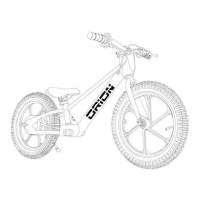6
Electric Balancer Pre-
BEFORE RIDING
1.
WARNING
–
ON AND OFF -ROAD CONDITIONS:
The condition of the
riding surface is very important to your safety. If the surface is wet, or has
sand, leaves, small rocks or other loose debris on the surface where you
plan to ride, carefully decrease the speed of the bicycle and ride with
extra caution. It will take a longer time and more distance to stop. Apply
the brakes sooner and with less force. Always apply the rear brake first
allowing time and distance for it to take effect. Then follow by cautiously
applying the front brake, in order to maintain control of the bicycle. Rapid
front brake application first may cause a front pitch over or fall. Learn to
use your brakes properly under controlled conditions until you learn
proper braking under all road conditions.
2.
NOTICE: State and federal regulations require a full set of
reflectors. Some state and local laws may require that your bike be
equipped with a warning device, such as a horn or bell and most
states require a
light. The manufacturer and many legal authorities DO NOT approve or
encourage riding at night. Vision is quite limited at dawn, dusk and at
night for bike riders, motorists and by-standers. If you must ride at night,
take extra precautions, use front and rear lights, wear flashers on your
arms, wear light-colored clothing, and plan your route to ride in well
lighted areas avoiding heavy traffic areas.
3.
NOTE: Always wear shoes when riding a bicycle and avoid loose
fitting clothes. Wear a cuff band or trouser clip to keep pants or other
loose clothing from getting caught in the chain wheel. Long sleeves, long
pants, gloves, eye protection, a DOT/CPSC approved helmet, elbow and
knee pads are recommended. Helmet use is required by law in many
states and is always a good idea for your safety.

